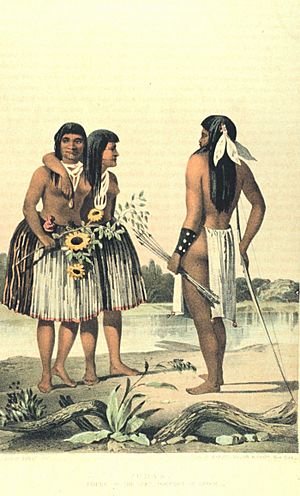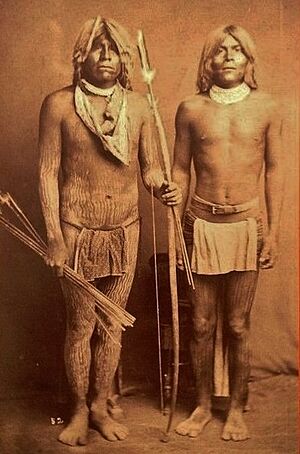Quechan facts for kids
| Kwatsáan | |
|---|---|
Quechan tribal seal |
|
| Total population | |
| 10,089 (2010) | |
| Regions with significant populations | |
| Languages | |
| Quechan, English, Spanish | |
| Religion | |
| traditional tribal religion, Catholicism | |
| Related ethnic groups | |
| Maricopa, Mojave, Kumeyaay, Yavapai |
The Quechan (called Kwatsáan in their own language, meaning 'those who descended'), also known as the Yuma, are a Native American tribe. They live on the Fort Yuma Indian Reservation. This reservation is located along the lower Colorado River in Arizona and California. It is just north of the border with Mexico. Even though their name sounds similar, they are not related to the Quechua people from the Andes mountains.
Members of this group are part of the Quechan Tribe of the Fort Yuma Indian Reservation. This tribe is officially recognized by the U.S. government. Their main office is in Winterhaven, California. Most of their operations and reservation land are also in California.
Contents
The Quechan People's Story
The Quechan people who lived in this area long ago were very skilled. They were good warriors and active traders. They traded goods with other tribes, like the Pima in southern Arizona and New Mexico. They also traded with people living near the Pacific coast.
First Contact with Europeans
The Quechan first met Europeans in the winter of 1774. This was when the Spanish explorer Juan Bautista de Anza and his group arrived. At first, their relationship was friendly. When Anza returned from his second trip to Alta California in 1776, the Quechan chief and three other men traveled to Mexico City. They asked the Spanish leader there to build a mission for them.
Chief Palma and his three friends were baptized in Mexico City on February 13, 1777. Palma was given the Spanish name Salvador Carlos Antonio. Juan Bautista de Anza had promised the Quechan people that a mission would be built. He said everyone would live together equally. Anza also gave Palma's people gifts like horses, steel tools, clothes, and iron. These gifts were a sign of their friendship.
Growing Problems with the Spanish
However, this friendship soon became difficult. The Spanish government was slow to build the missions. When the first Spanish gifts finally arrived in 1780, they caused problems. The livestock (farm animals) brought by the Spanish trampled and ruined most of the Quechan's crops. That year, there was also very little rain. This forced the Quechan to raid a nearby tribe called the Maricopa for food.
The next year, two important members of the Quechan tribe were arrested. The Spanish claimed they were planning to harm a high-ranking officer. One of the native men was put in stocks, which was a way to humiliate him. This event caused Chief Palma to turn against the Spanish.
Spanish settlements among the Quechan did not go well. The tribe rebelled from July 17 to 19, 1781. During this rebellion, they killed four priests and thirty soldiers. They also attacked and damaged the Spanish mission settlements. These were San Pedro y San Pablo de Bicuñer and Puerto de Purísima Concepción. Many people were killed there. The next year, the Spanish fought back against the tribe. After 1840, the Quechan people near La Frontera went back to their traditional religious ways. This happened when the mission priests left and no one replaced them.
Conflict with the United States
After the United States took over these lands from Mexico, they fought the Yuma War. This war lasted from 1850 to 1853. It started because of a conflict between the Quechan and some ferry operators. The Quechan had started their own ferry service on the Colorado River. During this war, Fort Yuma was built. It was built across the Colorado River from where the city of Yuma, Arizona is today.
Exploring La Sierra de las Pintas
La Sierra de las Pintas was a mountain range that Spanish explorers usually avoided. The Quechan people told them that the area was not good for living. They said it had no drinkable water.
When the Spanish asked the Quechan to guide them through these mountains, the Quechan would lead them to areas with very little water. This was done to discourage the Spanish from exploring further. Later, the Spanish tried to explore the mountains on their own. They looked for water in clever ways. For example, explorers would follow herds of Bighorn Sheep up the mountain. Sometimes, they would find small patches of plants that showed where a hidden water source might be.
The Yuma Trade Route
The Yuma route was an important trail. It ran from Southern New Mexico to Chihuahua and Sonora in Mexico. This trail also branched out to reach the Los Angeles Basin, San Diego, the Colorado River, and the Gila River. This route was well-known and used for trade among different tribes long before the Spanish arrived.
At first, the Spanish only used small parts of the trail. But once San Diego and Monterey were settled, they needed a faster and more reliable path. The first person to walk the entire path was Sebastian Taraval. He was a Cochimi native who had run away from San Gabriel. Captain Juan Bautista de Anza then followed Sebastian. Anza could only follow Sebastian to the Imperial Valley Kamia village. From there, he had to find the Quechan people on his own.
Population of the Quechan
It is hard to know exactly how many native people lived in California before Europeans arrived. Alfred L. Kroeber, a famous expert, estimated that about 2,500 Quechan lived in 1770. Jack D. Forbes, another researcher, thought the number might have been around 4,000 or more before they first met Europeans.
Kroeber estimated that in 1910, there were about 750 Quechan people. By 1950, almost 1,000 Quechan were living on the reservation. More than 1,100 lived off the reservation. The 2000 census reported 2,376 people living on the Fort Yuma Indian Reservation. As of 2023, there are about 4,000 active members of the tribe. They live on or near the reservation.
Quechan Language
The Quechan language is part of the Yuman language family. The Quechan tribe has worked with language experts to create a detailed language guide. This guide includes their alphabet. It also has words for actions, animals, body parts, colors, directions, family, friends, house, money, nature, numbers, places, plants, time, and shapes.
Fort Yuma Native American Reservation
The Fort Yuma Indian Reservation is part of the Quechan's traditional lands. It was created in 1884. The reservation is located at 32°47′N 114°39′W / 32.783°N 114.650°W. It covers about 178 square kilometers (68.8 square miles). It is in southeastern Imperial County, California, and western Yuma County, Arizona. It is near the city of Yuma, Arizona. Both the county and the city are named after the Quechan tribe.
See also
 In Spanish: Pueblo yuma para niños
In Spanish: Pueblo yuma para niños



